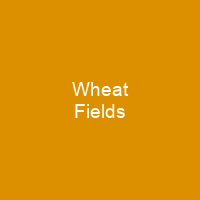Van Gogh’s Wheat Fields: A Journey Through His Artistic Vision
Imagine a world where every stroke of Vincent van Gogh’s brush was a whisper of his soul. In the series of paintings known as Wheat Fields, we see not just fields, but a profound exploration of life, faith, and human struggle.
The Call to Art
What if your calling wasn’t found in the church, but in the vibrant colors of nature? Van Gogh’s journey from a failed minister to an artist is a testament to his deep-seated belief that art could be a divine expression.
The Wheat Field as Symbol
Wheat Fields are more than just landscapes; they are metaphors for the cycles of life, growth, and the struggle against nature’s forces. Each field is a canvas painted with the colors of hope and despair.
Agriculture and Art
Van Gogh found inspiration in the manual laborers he observed. He saw their dedication as a reflection of his own artistic journey, striving to overcome the challenges that nature presented just as they did.
The Influence of Nature
Nature was not just a backdrop for Van Gogh; it was his muse. His paintings of wheat fields are a celebration of the natural world, with each stroke of the brush capturing the essence of growth and decay.
Color and Technique
Van Gogh’s move to southern France marked a turning point in his artistic career. The vibrant colors and dramatic use of light transformed his work from somber to expressive, almost as if he was channeling the very essence of life itself.
The Sunlit Fields
In the sun-drenched landscapes of Provence, Van Gogh’s paintings came alive with a new intensity. The fields became more than just scenes; they were symbols of his inner turmoil and spiritual quest.
Wheat Fields in an Asylum
Even as he faced mental health challenges, van Gogh continued to paint the wheat fields from his asylum window. These works are a poignant reminder of his resilience and the enduring power of art during times of struggle.
The View from Saint-Paul
From his studio at the Saint-Paul Asylum, Van Gogh painted the same wheat field over and over again, each version capturing different moods and emotions. These paintings are a testament to his unwavering commitment to his craft.
A Final Journey
The wheat fields of Auvers-sur-Oise were where van Gogh’s life came full circle. His final works, including Wheat Fields after the Rain, reflect both the beauty and the sadness of his last days.
A Lasting Legacy
Van Gogh’s wheat fields are more than just paintings; they are a window into his soul. Each field tells a story, a testament to his enduring spirit and artistic vision.

Through his wheat fields, Van Gogh invites us to see the world through a lens of beauty and struggle. His art is a reminder that even in our darkest moments, there is always hope, just like the promise of new life in the fields.
You want to know more about Wheat Fields?
This page is based on the article Wheat Fields published in Wikipedia (retrieved on November 29, 2024) and was automatically summarized using artificial intelligence.







